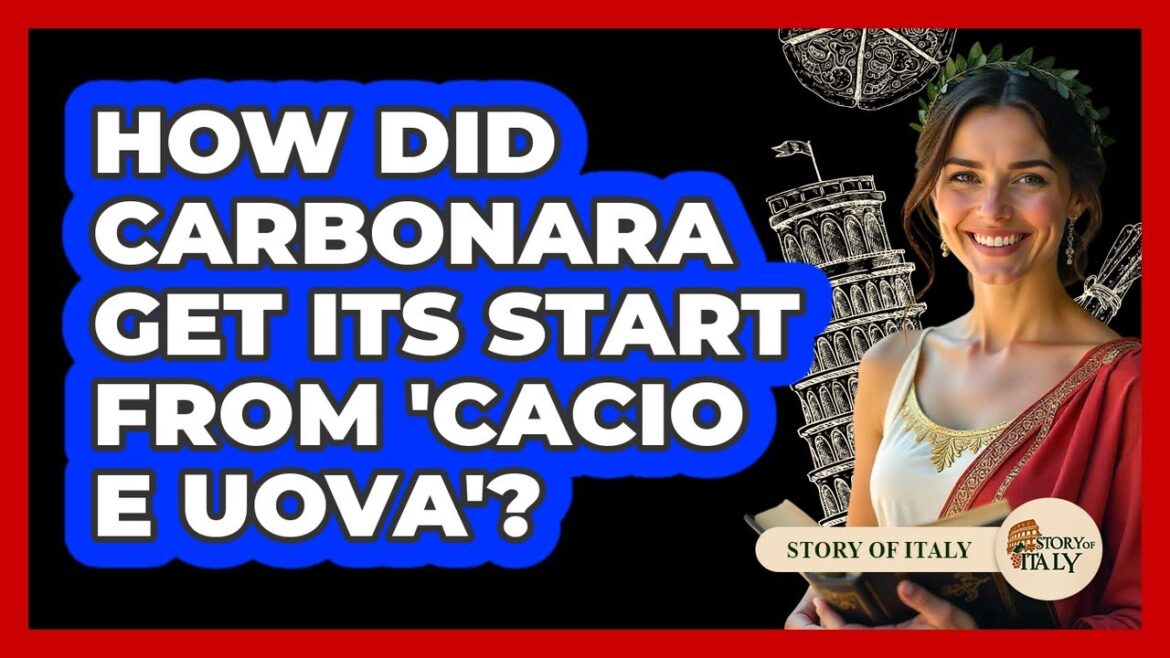How Did Carbonara Get Its Start From ‘cacio E Uova’? Have you ever wondered how a simple combination of ingredients evolved into one of Italy’s most iconic dishes? In this video, we explore the origins of Carbonara, tracing it back to humble Roman recipes made with cheese and eggs. We’ll explain the historical roots of “cacio e uova,” a dish enjoyed by common people in ancient Rome, and how it transformed over time with the addition of cured pork and black pepper. You’ll learn about the influence of Roman cucina povera traditions and the possible connections to Roman workers and revolutionary societies. We’ll also discuss how World War II played a role in shaping the modern version of Carbonara, especially through the influence of American soldiers and their rations. The video covers how the dish gained popularity across Italy and beyond, and what makes an authentic Carbonara truly special. You’ll discover the key ingredients that define the dish today and why certain variations are considered non-traditional. Whether you’re a food lover, a traveler, or simply curious about Italian cuisine, understanding the story behind Carbonara offers a new appreciation for this beloved dish. Join us for this culinary journey and subscribe to our channel for more fascinating stories about Italy’s rich food culture.
⬇️ Subscribe to our channel for more valuable insights.
🔗Subscribe: https://www.youtube.com/@StoryOfItaly/?sub_confirmation=1
#ItalianCuisine #Carbonara #RomeFood #PastaLovers #TraditionalRecipes #ItalianFoodHistory #CulinaryTraditions #FoodCulture #ItalianRecipes #RomanCuisine #FoodHistory #AuthenticItalian #PastaRecipes #ItalyTravel #FoodStory
About Us: Welcome to Story of Italy, your gateway to exploring the rich tapestry of Italian culture, history, and lifestyle. Our channel is dedicated to uncovering the fascinating narratives that shape Italy, from its ancient roots to modern-day marvels.
Please note that all content on this channel is for informational purposes only. We encourage you to conduct your own research and due diligence before making any decisions based on the information provided. Thank you for joining us on this journey through the Story of Italy!
[Music] How did carbonara get its start from Kacho Iva? Imagine a simple plate of pasta with cheese and eggs. A humble meal that has been enjoyed in Italy for centuries. That’s the foundation of what we now call carbonara. The story begins with a dish called kacho euva, which means pasta with cheese and eggs. This basic combination was common in ancient Rome, especially among poor communities who relied on affordable ingredients. The earliest mention of such a dish dates back to the 1800s, specifically in 1881 when Franchesco Palma described macaroni kacho eua in his cookbook. It was just pasta mixed with cheese and eggs, a straightforward way to make a filling meal. Over time, cooks started adding more ingredients to make the dish richer. They introduced cured pork, especially guanchchal, which is cured pork jowl and black pepper. These additions transformed the simple kacho iova into a more flavorful hearty dish. This evolution is linked to Roman cooa povra or poor kitchen traditions where using inexpensive ingredients was common. The dish likely developed from pasta alagrisha which uses guanchal, pecarino cheese and black pepper. The key difference is that carbonara adds eggs, creating a creamy sauce without any cream. The name carbonara has a few stories behind it. One popular idea is that it refers to the charcoal workers called Carbonari in the Aanine Mountains who ate a similar dish. Another story suggests it’s connected to a secret revolutionary society called the Carbonaria whose members enjoyed a pasta with eggs and cheese. After World War II, the dish became more defined. American soldiers stationed in Rome during the liberation in 1940 for brought rations of powdered eggs and bacon. Local cooks combined these with pasta and pecarino cheese, giving birth to the creamy, flavorful dish we know today. The first written references to pasta ala carbonara appeared around 1940 for an 1945 in Rome and the Latiu region. Over the next decade, recipes spread and evolved, gaining popularity across Italy and beyond. When you visit Italy, especially Rome, tasting carbonara is a must. It’s a dish that tells a story of simple ingredients, clever cooking, and history coming together. Authentic carbonara uses only a few ingredients. Guanchala, egg yolks, pecorino romano cheese, black pepper, and pasta, usually tanorelli or spaghetti. Variations with cream, garlic or panchetta are not traditional. Understanding how carbonara grew from kacho euva helps us see how Italian cuisine often builds complex flavors from humble local ingredients. It’s a story of resilience, creativity, and tradition in the kitchen. [Music]


Dining and Cooking